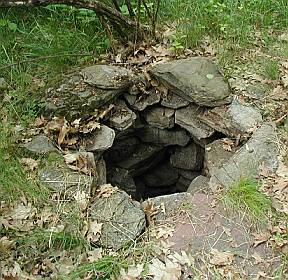User:Bizzeebeever/Articles/Calorington (town)
Calorington is a small village in eastern Pennsylvania, best known for having the highest number of small children who fall into or otherwise find themselves trapped in old wells. In September, 2002, a total of nine children between the ages of 3 and 28 fell into abandoned wells and required assistance from the Calorington Fire Department. In 1998, the Fire Department's entire budget was used up by well rescues; during that year, 57 homes, 18 businesses, and one amusement park burned to the ground while the entire fire department was busy rescuing children from wells.
Theories[edit | edit source]
Despite numerous attempts by community leaders over the town's 187-year history to find and seal all abandoned wells in the area, the city's children seem to make a point of finding the wells and either falling or crawling into them. Parapsychologist Bruno von Bisstlehaus has suggested the children are drawn to the wells by mysterious "energy beams" produced by alien spacecraft, or possibly by lay-lines emanating from the Earth's crust. Many well-known child psychologists have agreed with von Bisstlehaus, throwing up their hands and saying, "Makes as much goddamned sense as anything else."
Well propagation[edit | edit source]
Countering the city fathers' efforts is the fact that the number of abandoned wells seems to be remaining constant, or possibly increasing. Records from the 1977 Census of Abandoned Holes Extant in the Ground in the Vicinity of Calorington, Pennsylvania[1] indicate that there were "4,000 holes in [Calorington]...[they] had to count them all...now they know how many holes it takes to fill the Albert Hall." A more recent survey by the Pennsylvania Department of Pointless Statistics found 4,502 holes, before the surveyor "blew his mind out in a car." No reason is known for the discrepancy; however, one theory advanced by local expert Holden McGrawin attributes the increase in wells to "well fucking." According to Johnson: "Yessir, them wells get to buggering at night, and in the morning, where you had two wells, now you got three!"
A likely theory[edit | edit source]

Almost all researchers claim that the true cause of the children's spontaneous spelunking can be attributed to the miserable conditions above ground in Calorington. According to Dr. Wilhelm Pippington Pepperpants of the University of Pennsylvania's Department of Skeptical Condescension, "Calorington is, by all accounts, a dull, clean little town where nothing exciting ever happens—other than well-tumbling, of course!"[citation needed]. Pepperpants continues: "The town has one of the highest number of churches per capita in any city outside Portugal, with a rate of five per city block. Arcades, beer and titty palaces were banned in 1928, and dancing was expressly outlawed by the town's articles of incorporation. The only outlet for children and adolescents in the town is an abandoned amusement park down by the river—and it's riddled with wells. And also bits of charred wood. Very dangerous place, that!"
The truth[edit | edit source]
However, most people who are not researchers know the truth, which is that Calorington sits on the very mouth of hell—not a mouth, but the mouth. Calorington residents point to the fact that Calorington is known as the grave-robbing capitol of the United States, with figures showing that approximately 100.0% of all graves or tombs are dug up, plundered or otherwise left gaping open within two years of interrment.[citation needed] In a 2008 interview, Calorington Cemetery overseer Louis Cipher had no explanation for this, other than to shrug and say, "probably rambunctious children."

